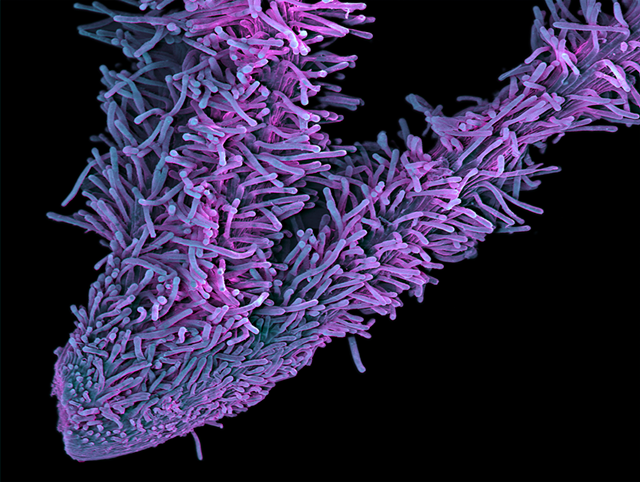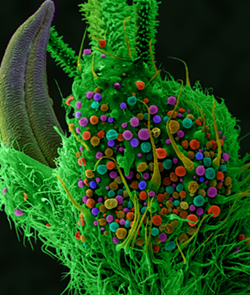Numerous a hashish shopper has an personal partnership with his bud. But couple have gotten as up near and own with pot as Ted Kinsman, a scientific photographer at Rochester Institute of Technological innovation who does not indulge in the jolly inexperienced grass.
When Kinsman’s otherworldly pictures of microscopic pieces of the cannabis plant started out circulating on the online in 2018, not anyone thought what they have been seeing. Some took to Snopes.com to verify that the suspiciously psychedelically-hued illustrations or photos have been correct representations of pot.
The sleuthing web page verified that they were authentic illustrations or photos of hashish, but clarified that Kinsman experienced digitally colorized them to make pieces of the plant pop — specifically the components that get you high.
Kinsman, a professor in the Photographic Sciences Office at RIT, posted his photographs along with an essay explaining how and why he made them, in a 2018 guide titled “Cannabis: Marijuana Below the Microscope.”
His shut-up photographs of hashish glance like alien landscapes — lively forests with Dr. Seuss-like trees enveloped by a pitch-black vacuum.
“I like to consider it’s what a individual would see if they were just a couple microns tall and walking as a result of these forests,” Kinsman told Tech Insider soon immediately after his guide released. For reference, the common strand of hair is 70 microns broad.
Kinsman digitally hues most of the plant with a lively gradient of environmentally friendly, though he takes advantage of sweet-like pinks, purples, and blues to emphasize the glandular trichomes — bubble-like sacs stuffed with a concentration of the chemical tetrahydrocannabinol, far better identified as THC.
Extra than just a collection of participating pictures that may possibly charm any abstract artwork-loving collector, Kinsman’s e-book dives deep into the trivia of the plant, checking out cell biology and the buildings and features of its parts in an very easily understandable way. He solid his strategy as “plant biology lite” in a conversion with Metropolis.
“My target is to inspire regard for hashish, as very well as the beauty of all vegetation in the normal globe,” Kinsman wrote in the introduction to his reserve.
Chatting with Kinsman, it is apparent that he’s enthusiastic about normal phenomena and artful engineering, but also that he has a whole lot of enjoyable with his explorations. His fascination is infectious when he discusses the buildings of snowflakes, engineering a machine that prints dot matrix portraits out of espresso drips, or recommendations on building a cocktail drinkbot.
Kinsman says his target is to make science as visually pleasing as doable to everyday individuals. He’s performed it. Although his images won’t be observed in an art gallery, they have located their way into pop lifestyle.
His cannabis imagery and other do the job have been highlighted in science publications, Tv exhibits, and commercials. Time-lapse imagery he created of a rose blooming accompanies the opening credits of “The Bachelor.” Other photos of his have been observed in episodes of “CSI: Criminal offense Scene Investigation,” “Grey’s Anatomy,” “American Idol,” and “The X-Documents.”
In 2019, the BioCommunications Affiliation honored Kinsman with its most prestigious commendation, the Louis Schmidt Award, which acknowledges excellent contributions to the progress of biocommunications.
While the wildest-on the lookout of Kinsman’s hashish pictures are scientifically correct, they are not photos. There is no digital camera associated. They’re visuals produced with a Scanning Electron Microscope (SEM), which bombards cautiously selected and arranged freeze-dried plant samples with electrons. The microscope scans the surface area topography of the sample, and produces a high-resolution picture applying that information. That requires about 4 minutes. Kinsman then painstakingly colorizes the picture in Photoshop. That portion takes hrs upon hours.
For 10 several years, Kinsman had his own SEM in his residing place, right up until it broke down about two years back and he scrapped it. His spouse was pleased to get the room back, he explained.
“What most men and women do not understand is a scanning electron microscope is about the dimension of the VW Bug,” he mentioned. “And it weighs all around 2,000 lbs.”
Kinsman said he likes to target on building images of things that some others haven’t completed prior to, or have not carried out properly.
Just lately, he intended a bicycle with a big Spirograph-like equipment affixed to it that permits the rider to develop Spirograph-like drawings by pedaling. Kinsman presents his engineered art-satisfies-science creations at makers’ fairs.
“I’m not genuinely an artist,” Kinsman reported. “I just try out to offer science the best I can.”
Rebecca Rafferty is CITY’s daily life editor. She can be reached at [email protected].




